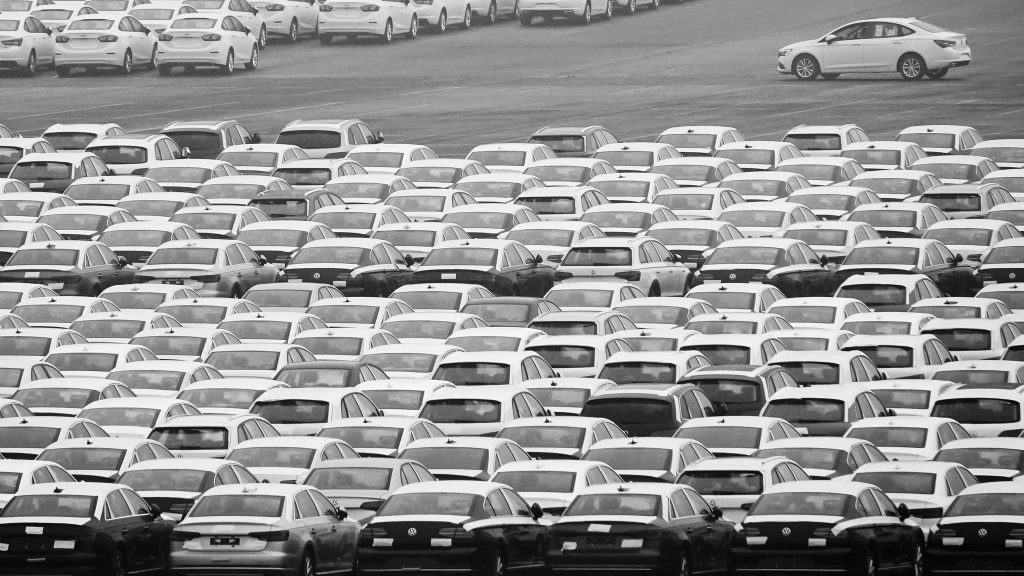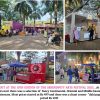Goa is abuzz with excitement as vintage bike and car owners, users, collectors and fans are decking […]

DECLINE OF MANUFACTURING AFFECTING JOBS!
June 08- June 14 2019, Stray Thoughts June 7, 2019WORST: The biggest suffers of the slow down of the economy under Modi are automobile and two-wheeler makers, where the demand has fallen by 20%-30%
BY RAJAN NARAYAN
And a few stray thoughts for yet another Saturday. For a Saturday following the week when the Centre backtracked on its decision to impose Hindi as part of the three-language formula. For a Saturday following the week when we discover that it not only the southern States, but Goa also opposed the imposition of Hindi. For a Saturday following the week when jobs have become a major problem not only in Goa but all over the country. For a Saturday following the week when there was a major slump in the production of four-wheelers and two-wheelers. For a Saturday following the week when civic bodies appear to be helpless in dealing with the garbage problem. For a Saturday following the week when the posh seems to be getting nervous about whether they will lose their privileges.
HINDI NOT MANDATORY
And a few stray thoughts on the Modi government reversing its stand on making Hindi compulsory in all parts of the country.
Based on the Kasturirangan report, the HRD Ministry announced a draft education policy. Under the initial version of the draft education policy, besides the mother tongue and English, all students in the country had to learn Hindi. The excuse was that knowledge of Hindi was essential for getting a job in the country — which is not true.
Even earlier, attempts were made by North-dominated Central governments to impose Hindi on the entire country. During the earlier attempt over four decades ago there was a major agitation in all the southern states. What the Delhi Ministers and officials do not understand is that culturally the states south of the Vindiyas, which include Tamil Nadu, AP (now split into Andhra and Telangana), Karnataka and Kerala, are very different from northern states like Haryana and UP.
While each of the southern states is proud of its own individual language and culture, they have a common believe that they are Dravadians as opposed to the northern people who are considered Aryans.
The food habits of the south are in total contrast to those of the residence of the north. While idli and dosa and rice are the staple diet of those in the south it is roti and sabji and dal in the north. The dress habits are different — the basic dress of the south being white lungis with shirts, while in the north it is more of the pajama-kurta culture. Including now the Modi jacket. The women of the south traditionally wear sarees including the half saree for unmarried women who have reached puberty. In the north it is the salwar kamiz. The north remains more traditional and strict with women. Many colleges in the North which have banned tops and jeans for women, with some leading BJP politicians claiming that western outfits provoke men and lead to rapes.
Even politically the south is different from north as regional parties are in power in most southern states. The south was not swept away by the Modi wave during the recent parliamentary elections. The BJP hardly got any states in the south, particularly in Tamil Nadu, Kerala, Andhra and Telangana. The only southern state in which they got some seats was Karnataka because of the fight between the coalition partners, the Congress and the Janata Dal (Secular).
It is a good sign for democracy and for us liberals that after protests the Modi government immediately changed the policy of making Hindi compulsory. Under the new draft it is not compulsory to study Hindi as the third language in all parts of the country. As a senior BJP leader himself pointed out how would it help somebody in Chennai to learn Hindi.
HINDI IN GOA
And a few stray thoughts on Goa being among the States which has no fondness for Hindi.
Many primary schools in Goa are still Marathi-medium, particularly government schools. This is because till Liberation there were only Portuguese-medium schools in Goa. Moreover only the rich and the Saraswats had access to education.
When Bandodkar became the first chief Minister after the MGP victory in the first elections, he started over 1,500 Marathi schools in every village in the Goa to provide all castes and communities access to educations. It was a very practical decision which empowered the poorest of the poor. The MGP did not deny the poor the benefit of English education but at the primary level the medium of instruction was Marathi. From the 5th standard onwards the medium was English. When Sashikala was the education minister in the UDF government in the early ‘90s she modified the rule to limit grants only to schools teaching in the mother tongue. This meant that not only Marathi and Konkani schools but Kannada, Telugu, Malayalam and even Urdu schools could get grants for primary education.
Interestingly, while the various communities which had come to Goa to fill job vacancies (ranging from teachers to engineers) set up their own schools, nobody showed any interest in setting up a Hindi school.
The problem with trying to impose languages — whether the mother tongue or not — is the belief that only English is the key to success. This can be seen very clearly in the state of Goa. As against the 1,500 Marathi schools in the ‘70s there are now less than 500 Marathi schools. The enrolment even in these 500 schools is often less than 10 as against the minimum requirement of 40 per class.
Goa may hit very high pass percentages in SCC and HSSC. But the facts remains that Marathi-medium schools are closing down or merged. Despite efforts by ardent Konkani mogies the number of Konkani school are also not going up significantly. There are less than 100 Konkani primary medium schools in Goa though it is the official language of the state. The largest number of schools in Goa, even in the primary level, are in English. Even migrants who work as maid servants or garbage collectors insist on sending their children to English-medium schools even if they have to pay high fees.
There is a peculiar situation in Goa — only English-medium primary schools run by the Church get grants, while private English-medium primary schools do not get grants irrespective of whether they are run by Hindus or Catholics.
Even if you are willing to pay, migrants often do not get admission to English medium primary schools as very few Church school, with a rare exception like Auxilium, admit migrants. Interestingly, the only school which admits the children of migrants without demanding any certificates such as domicile and date of birth etc is St Michaels school run by Panjim MLA Babush Monserrate. But even this is not free with the fees averaging `1,000 per month, a very heavy burden. As against this it must be mentioned that Babush pays the fees of all migrants who approach him and has been doing this for the last 15 years at least.
JOBS & MANUFACTURING
And a few stray thoughts on the link between education and jobs.
The problem is not even English will guarantee you a white-collar job. Particularly in a state like Goa. Knowledge of Konkani, Marathi and perhaps a little English and Hindi may help unskilled Goans. Even Swiggy and Zomato delivery boys have to produce a tenth standard pass certificate and have knowledge of Hindi. In the messages that these food delivery chains send they often say that the delivery boy speaks Marathi and Hindi. I don’t understand why Subhash Velingkar or Rohan Khaunte, who insist that Goans should be given first preference, do not tell Swiggy and Zomato that they should not hire young people who do not know Konkani. In fact if they make knowledge of Konkani essential, more 10th standard students will get a job.
Besides courier, food delivery, or sales man jobs, which do not require specific skills, all other blue-collared jobs require vocational skills. Nobody will set up an automobile factory in Goa because there are very few polytechnics offering courses in auto engineering. Similarly there are not enough courses for mechanics who can get production jobs in factories. The majority of employees in the pharma units in Verna are from outside Goa.
Part of the problem is that most of the pharma graduates are girls who will not work on the night-shifts. A friend who used to work for a multinational company in the Verna Industrial Estate complained that part of the problem was the Goans do not have a work ethic. Which is why even existing factories have to get people from outside the state. The irony is that Goan engineers and diploma holders go to Pune and Bangalore looking for jobs because the salaries are higher and their expectations are higher than what employers are willing to pay to fresh graduates. A fresh graduate, except in commerce, cannot expect to get even `10,000 in a private company in Goa. Many of them are not willing to acquire experience which will qualify them for better jobs.
Modi has been talking about ‘make in India’. Unfortunately we do not have the technology to ‘make in India’. Even the Maruti, which was a first car to be made in India, had a tie up with Suzuki of Japan. The automobile industry which has grown very rapidly in the country has been a major source of jobs. But unfortunately over the last six months the demand for cars has fallen sharply. Maruti is the worst hit with a 25% drop in sales. Even the sales of scooters and motor cycles has fallen rapidly. This is because unemployment is very high and people do not have purchasing power. Another factor is that banks have become very cautious in giving loans after all the scams.
Co-operative banks like Mapusa Urban Co-operative Bank and Madgaum Urban and even the apex Goa State Cooperative Bank are in trouble. All three banks have been slapped with stringent restrictions on their operations by the RBI after it found that they have been flouting the rules in giving loans under influence.
The big opportunity for India and Goa is the fight between the United State and China. The United States is not letting mega Chinese technology companies come to import or market goods particularly electronic. China has retaliated and is in the process of asking Apple (the iPhone maker) to leave the country. If Modi is enterprising he can get Apple and other major telecom companies like Samsung to ‘make in India’.
SONSODO FIRE
And a few stray thoughts on the dismal state of civic bodies in Goa.
The Sonsodo fire has not been put out even after seven days. There is a garbage problem in almost every municipality in the state. Interestingly the garbage problem is much less in the non-coastal villages. Though Panjim was the first city to organize house to house collection of garbage in segregated form it has no garbage dump. Vasco has no total collection though it was the first city to set up a waste management plant. The Sonsodo waste management plant is a scandal which has been abandoned by the Timblos after bleeding the MMC.
The primary problem when it comes to waste management or any other civic issues is that mayors and councillors have no power. All the power is in the hands of a commissioner in the case of Panjim, and the chief officer in the case of other towns. The chief officers are the bosses and do not have to listen to elected representatives. In fact during the by-election to Panjim Babush complained that the BJP government was deliberately posting officers who would not carry out the orders of the elected bodies.
The mayor has got power only in name as he has no authority to sanction any funds. Ironically the mayor makes the budget, but cannot spend it. The amendments to the Constitution which stipulate that civic bodies and panchayats should have all powers including financial powers must be enforced.
To give an example the Margao municipality faces delays in buying a chemical for the Sonsodo fire and hiring more labour because the chief officer did not release the grants. Ultimately it is babus who called the shots and should be held responsible.
LIBERAL ELITE?
And a last stray thoughts on the defeat of the liberal elite by the illiterate chai wala.
Modi has been talking contemptuous of the Khan Market set. The equivalent would be the Altinho set and the Dona Paula set. The label refers to the upper middle class who enjoy many privileges which the working class do not have. The upper middle class can afford not only gas cylinders but washing machines and air conditioners to skip the heat. They can provide the best education for their children. Every elite family has more than one car. And often allow their children who are below the driving age to misuse the cars.
This posh, liberal set cannot come to terms with the Modi victory. They see the victory of Modi as a revolt by the under privileged, but don’t understand it. Ironically the truth is that instead of helping the poor Modi himself has joined the rich after becoming prime minister. As many of you must have realised he has become very fashion conscious. He even wore a gold thread-striped suit when Obama was chief guest at the Republic day ceremony.
The majority of his Cabinet are also part of the posh set. Amit Shah has a degree in management from the Unites States and is a rich businessman. Finance Minister Nirmala Sitaraman is a graduate of not only JNU (an institute now accused of sedition), but has also got a degree from the London School of Economics. Modi’s closest friends are the Ambanis, Adanis and other rich industrialists.
Power corrupts and absolute power corrupts absolutely. Not everyone who lives a comfortable life is in sensitive to the condition of the common man.
The problem with the Indian elite and the widening gap between them and the common man is that they have not imbibed the charitable attitude of Bill Gates in the US or Infosys’ Narayana Murthy who rewarded even drivers and peons with shares. A Surat diamond tycoon gave every one of his employees a car and a house. Asin Premji of Wipro in India has gifted half his fortune of more than 20 billion for better quality education and other charitable causes. But these are rare. Perhaps it would help if the privileged are more sensitive to the poor.















